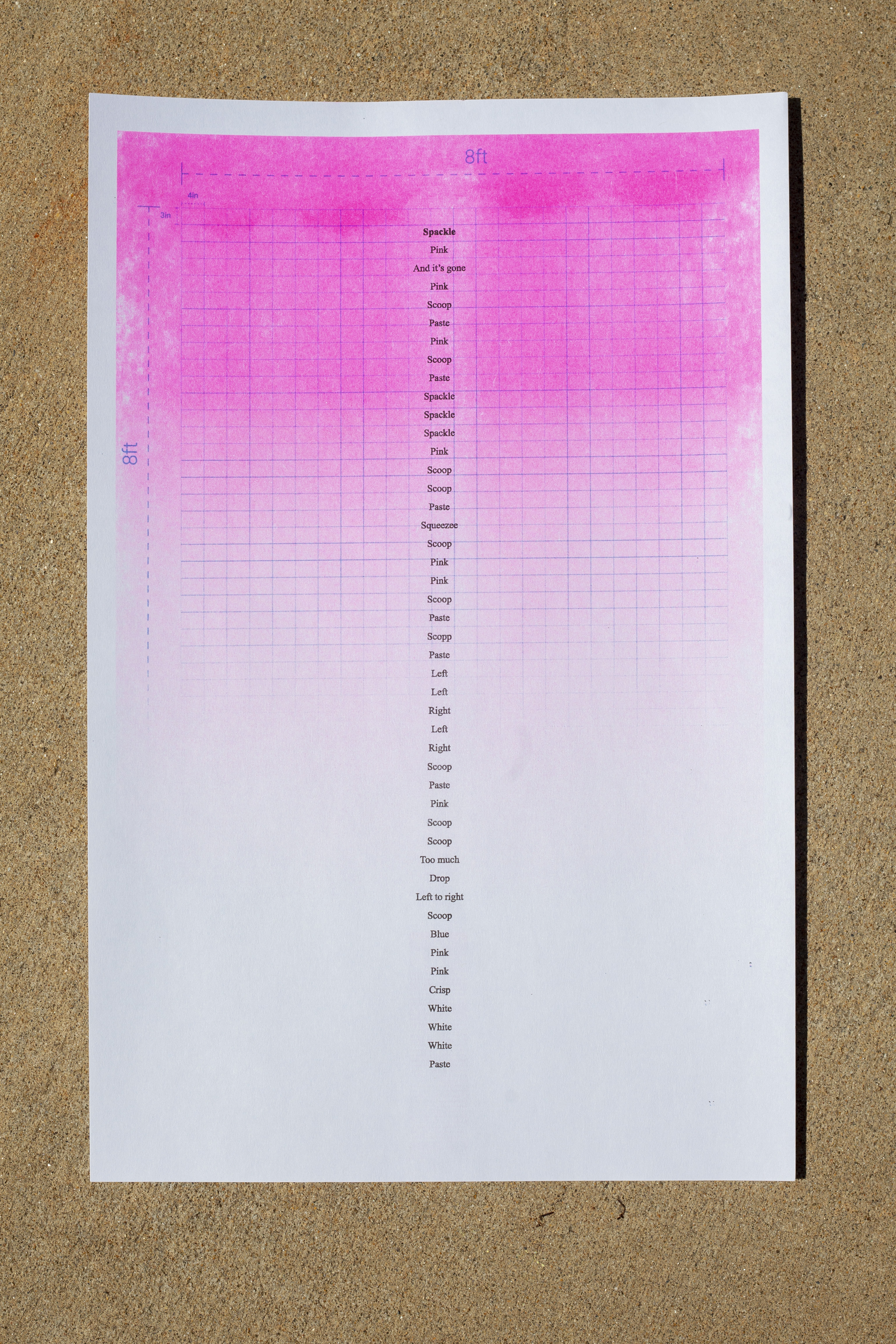
Documentation of the live performance...





Naomi Le
Scored Layers
3 hours
Pink spackle, 8'x8' wall panel, a small size squeezee*, the fallen spackle*, the empty buckets of spackle*
2023
Naomi Le Score
Size: 11 x 17 inches
Medium: Risograph
2023
Remnants from the Performance:
Spacke Buckets (each)
Size: 6 x 6 x 12 inches
Medium: used, empty, spackle bucket
2023
$50
Fallen Spackle (per pound)
Size: dimensions vary
Medium: dry spackle
2023
$100
Spackle Panels (each)
Size: 4 x 4 feet
Medium: dry spackle on plywood panel
2023
$500
why this was made...
Spackle is used in the performance art piece "Scored Layers" to examine the transforming potential of repetition and accumulation. On a huge canvas or wall the size of an 8-foot-by-8-foot grid, the artist continuously pastes scoops of spackle to it in a repeated action one scoop by one scoop from left to right using a 4 inch squeezee. The audience will see how the surface gradually changes from a flat, uniform grid to a rich, textured landscape of peaks and valleys as more layers of spackle are applied. The score acts as a compass that directs the artist as she explores the boundaries and potential of their physical and creative capabilities as the repetitive motion of pasting the spackle transforms into a peaceful and introspective act. Over the course of 120 hours, the material will change from bright pink to completely white. In addition, each scoop on the surface will also reflect the artist’s physical stage. As the performance goes on, the artist will start with a stable strength which leads to evenly scoops of spackle on the surface. Later on when the artist’s strength becomes weaker, she will scoop more material in hope of finishing the performance which will make the scoop become too heavy to stay on the surface and end up on the floor beneath the piece. "Scored Layers" urges the audience to focus on the intricacy, beauty of repetition and the inherent potential of materials we often view as mundane, and to think about the ways in which these ideas impact our individual and collective lives.
About the Artist:
My work shows the inherent potential of materials we often view as mundane. I use unconventional materials that are store-bought or found, including styrofoam, vacuum bags, and sponges. My investigations are rooted in the idea of exploring and transforming the use of everyday objects into something that is examined as art to provoke us to question our ability to observe the real world. In my process, I start with exploring a potential material such as multi-use copy paper by listing out the potential transformations: folding into three-dimensional shapes, cutting or tearing to get texture, or layering adhesive spray to give weight and texture. After successfully creating a satisfying transformation, I start producing the same piece numerous times to create the repetition element in my art practice. The imagery in my work is mostly inspired by nature, animal migration, dry vines on a wall, or flowers. I want to trigger viewers to think about a moment that they witnessed or interacted with in nature. Lastly, by attaching them all or letting them present individually together, the final vision for the piece always in some way mimics nature. For instance, sponges could be crawling on the wall like how ants follow each other. Or folded papers could be attached to each other using paper clips to create a natural scenery. My whole life in Vietnam, I saw rice fields every day. I see my work as a full field of vision – a full field of rice. Creating the idea and building the work remind me of childhood, an image of home.
My work shows the inherent potential of materials we often view as mundane. I use unconventional materials that are store-bought or found, including styrofoam, vacuum bags, and sponges. My investigations are rooted in the idea of exploring and transforming the use of everyday objects into something that is examined as art to provoke us to question our ability to observe the real world. In my process, I start with exploring a potential material such as multi-use copy paper by listing out the potential transformations: folding into three-dimensional shapes, cutting or tearing to get texture, or layering adhesive spray to give weight and texture. After successfully creating a satisfying transformation, I start producing the same piece numerous times to create the repetition element in my art practice. The imagery in my work is mostly inspired by nature, animal migration, dry vines on a wall, or flowers. I want to trigger viewers to think about a moment that they witnessed or interacted with in nature. Lastly, by attaching them all or letting them present individually together, the final vision for the piece always in some way mimics nature. For instance, sponges could be crawling on the wall like how ants follow each other. Or folded papers could be attached to each other using paper clips to create a natural scenery. My whole life in Vietnam, I saw rice fields every day. I see my work as a full field of vision – a full field of rice. Creating the idea and building the work remind me of childhood, an image of home.


